|
Click any typewriter
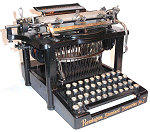
Remington 7 - 1895
Understrike typewriter
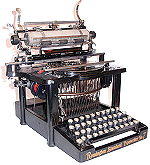
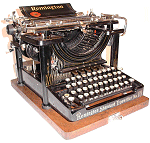
Remington 10 - 1910
Visible typewriter
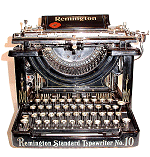
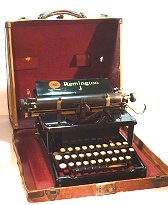
Remington
Junior -1914
'Luggable' typewriter
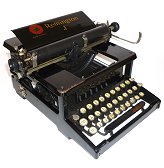
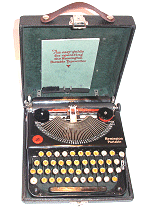
Remington
Portable 1920
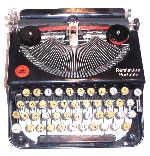
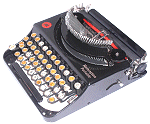
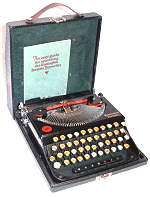
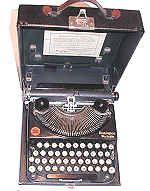
Remington
Portable #2 1925
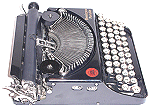
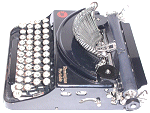
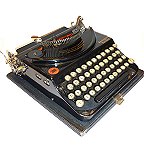
Remington
Portable #2 1927

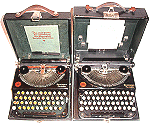
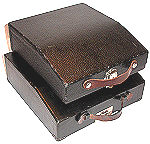
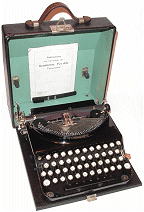
Remington 3 Portable 1933
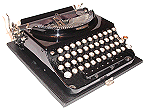

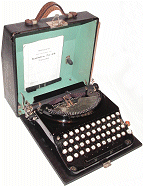

|
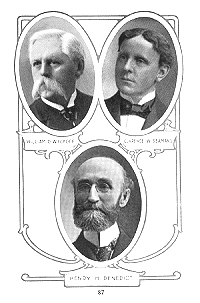 Remington had been the
leading maker of desk typewriters since the company
produced the first successful machine in 1878, after buying the patents of
Christopher Sholes and his co-inventors. This commercial dominance
was due primarily to William Wyckoff, Clarence Seamans and Henry Benedict -
names that adorned desks all over the world on Remington 7 and Remington 10
desk machines (see left). But by the time
the First War ended in 1918, the industry
had changed radically - typewriters had become portable. Remington had been the
leading maker of desk typewriters since the company
produced the first successful machine in 1878, after buying the patents of
Christopher Sholes and his co-inventors. This commercial dominance
was due primarily to William Wyckoff, Clarence Seamans and Henry Benedict -
names that adorned desks all over the world on Remington 7 and Remington 10
desk machines (see left). But by the time
the First War ended in 1918, the industry
had changed radically - typewriters had become portable.
Remington's first attempt to adapt to changing
markets was the Remington Junior of
1914 - the result of a joint effort between Remington and Smith Premier
(the two companies had merged in 1893).
It was manufactured in the old Smith Premier factory in Syracuse and
the design seems to have resulted from a collaboration between Arthur Smith
and John Barr of Remington, and Emmit Latta of Smith Premier. It differs
from the Remington 10 desk machine
in several important respects. Most
obviously, it has a three-row keyboard with two shift keys to provide the
full range of characters. The Junior’s mainframe is fabricated from
pressed steel, rather than cast iron. This results in a significant weight
saving, but the machine still weighs 16 pounds (against the Corona 3’s 7
pounds) making the Junior ‘luggable’ rather than truly portable. The
machine also employs the idiosyncratic ribbon mechanism designed by
Emmit Latta for Smith Premier in 1904.
In this arrangement, the ribbon spools are mounted at the rear of the
machine and fed under the carriage. It was so fiddly, that Remington
provided a special tool with each Junior for snagging the ribbon end and
drawing it through. It’s
thought that machines made for export to Europe bore the letter J on the
paper table, rather than the name ‘Junior’, like the machine illustrated
here.
The Junior was manufactured until 1919 when Remington finally caught up with
its main rival, Underwood, and responded to market demand for truly portable machines.
In October 1920 the company unveiled the Remington Portable shown below left. The
Remington Portable of 1920 was designed primarily by John H Barr, a
professor of machine design and mechanical engineering at Cornell
University. Barr was granted the patent for the Remington four-bank portable
on October 28, 1919. Almost exactly one year later the machine went into
production at Ilion in New York. According to the first edition (August 2,
1926) of The Remport - a newsletter for Remington portable sellers,
"The Remington Portable was first exhibited at the New York Business
Show in October, 1920. Its manufacture began shortly thereafter but for many
months only a limited number of machines were available for
delivery." The wait proved to be well worth while. Barr
and his team had created a sleek, low-profile machine with a full four-row
keyboard, just like its best-selling Remington 10 desk machine, but with the
works slimmed down dramatically. To appreciate fully the extent of the design team's
achievement, compare the Remington Portable with the company's standard desk
machine of the time, the Standard 10 (shown below). The keyboard is the
same size and layout as that of the desk machine, but everything else has been
miniaturised and crammed into a sleek box only an amazing three inches high.
This streamlined, low-profile design was an augury of the times, heralding the
Art Deco movement that was to 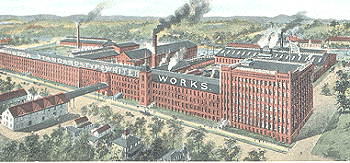 revolutionise industrial and interior design in
the 1920s and 1930s -- indeed the Remington Portable design is so far ahead of
its time, it is reminiscent of machines of the 1950s. The side view
shows how successful the
Remington engineers had been at meeting their design brief for the slimmest most
modern looking portable possible with current technology. The Remington
Portable of 1920 was not only beautifully
designed, it was also very easy to use because the shift mechanism moved the
carriage - not upwards - but smoothly backwards, almost horizontally, with
scarcely any effort. Remington quality was evident throughout in the
engineering and the marketplace greeted the new machine in much the same way
that IBM customers reacted to the introduction of the Personal Computer in 1982.
They bought the Remington Portable in tens of thousands.
The Remington factory in Ilion, New York, shown here, extended its
production capacity still further and the picture postcards boasted it was
able to manufacture a typewriter every minute.
Perhaps the one design flaw with the early Remington
Portables was that the engineers failed to deal satisfactorily with the need to
lay the type basket flat when the machine was stowed away in its case, and so
resorted to the clumsy device of having a typebar raising lever (see left) that had to be
pushed home to raise the typebars to the ready position before typing could
begin. This clumsy device was eliminated from the Remington Portable model
3 onwards, introduced in 1928 (see below left) and competing with the Remington
Noiseless as one of the most beautiful portable typewriters ever produced. As
early as 1876, Remington had a factory in London. What was manufactured in
London is not known with any certainty as every Remington desk typewriter
carried a clear message that it was "Manufactured by Wyckoff, Seamans
and Benedict, Ilion New York ." It may be that US-made export machines
for the British market were adjusted here. However, after the introduction
of the Remington Portable, the company began shipping manufactured parts
across the Atlantic for assembly at its London factory. These British
machines carry a notice informing customers that they were "Assembled
by British labour at the London factory of The Remington Typewriter Company
Ltd." Usually they did not carry the familiar red Remington seal
announcing that to "save time is to lengthen life" although the
example illustrated here does have it.The huge market success of this machine prompted Remington to embark
on a design spree for portables that lasted for fifty or more years. revolutionise industrial and interior design in
the 1920s and 1930s -- indeed the Remington Portable design is so far ahead of
its time, it is reminiscent of machines of the 1950s. The side view
shows how successful the
Remington engineers had been at meeting their design brief for the slimmest most
modern looking portable possible with current technology. The Remington
Portable of 1920 was not only beautifully
designed, it was also very easy to use because the shift mechanism moved the
carriage - not upwards - but smoothly backwards, almost horizontally, with
scarcely any effort. Remington quality was evident throughout in the
engineering and the marketplace greeted the new machine in much the same way
that IBM customers reacted to the introduction of the Personal Computer in 1982.
They bought the Remington Portable in tens of thousands.
The Remington factory in Ilion, New York, shown here, extended its
production capacity still further and the picture postcards boasted it was
able to manufacture a typewriter every minute.
Perhaps the one design flaw with the early Remington
Portables was that the engineers failed to deal satisfactorily with the need to
lay the type basket flat when the machine was stowed away in its case, and so
resorted to the clumsy device of having a typebar raising lever (see left) that had to be
pushed home to raise the typebars to the ready position before typing could
begin. This clumsy device was eliminated from the Remington Portable model
3 onwards, introduced in 1928 (see below left) and competing with the Remington
Noiseless as one of the most beautiful portable typewriters ever produced. As
early as 1876, Remington had a factory in London. What was manufactured in
London is not known with any certainty as every Remington desk typewriter
carried a clear message that it was "Manufactured by Wyckoff, Seamans
and Benedict, Ilion New York ." It may be that US-made export machines
for the British market were adjusted here. However, after the introduction
of the Remington Portable, the company began shipping manufactured parts
across the Atlantic for assembly at its London factory. These British
machines carry a notice informing customers that they were "Assembled
by British labour at the London factory of The Remington Typewriter Company
Ltd." Usually they did not carry the familiar red Remington seal
announcing that to "save time is to lengthen life" although the
example illustrated here does have it.The huge market success of this machine prompted Remington to embark
on a design spree for portables that lasted for fifty or more years. 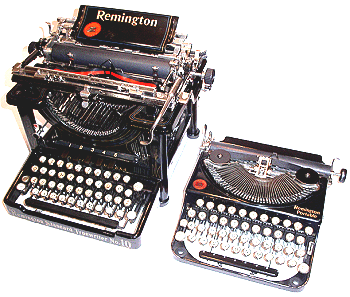 The
company produced a bewildering array of designs, variations, colours and
specifications. It also pressed into service well-known typewriter brand names that it had
acquired, such as Monarch and Smith Premier. Remington's most successful
acquisition was the Noiseless Typewriter Company, whose silent typing technology
they incorporated into a successful range of both desk and portable machines
(including the machine shown as the Home icon on this site.) In 1927, Remington Typewriter Company merged with another office equipment
company, Rand Kardex, to form Remington Rand. In 1949, Remington Rand introduced
the first business computer, the Remington Rand 409. Instead of an auspicious
new beginning, however, the computer signalled the end of the Remington name. In
1955, there was another merger, with Sperry Corporation. This time the Remington
name was dropped and the new company was known simply as Sperry Rand. Although
no longer on the letter heading, the Remington name continued to appear in the
1950s and 1960s on a range of portable typewriters and electric desk machines,
before finally disappearing with the advent of the computer age it had helped
found. The
company produced a bewildering array of designs, variations, colours and
specifications. It also pressed into service well-known typewriter brand names that it had
acquired, such as Monarch and Smith Premier. Remington's most successful
acquisition was the Noiseless Typewriter Company, whose silent typing technology
they incorporated into a successful range of both desk and portable machines
(including the machine shown as the Home icon on this site.) In 1927, Remington Typewriter Company merged with another office equipment
company, Rand Kardex, to form Remington Rand. In 1949, Remington Rand introduced
the first business computer, the Remington Rand 409. Instead of an auspicious
new beginning, however, the computer signalled the end of the Remington name. In
1955, there was another merger, with Sperry Corporation. This time the Remington
name was dropped and the new company was known simply as Sperry Rand. Although
no longer on the letter heading, the Remington name continued to appear in the
1950s and 1960s on a range of portable typewriters and electric desk machines,
before finally disappearing with the advent of the computer age it had helped
found.
___________________________
One aspect of the Remington Portable that is of
interest to collectors is that its design underwent a very large number of minor
changes over the first few years of production, especially the first year.
Remington records describe the later, modified version as the Portable #2,
leading collectors to refer to the original October 1920 model as the
Portable #1. In reality, there is a
whole spectrum of changes between #1 and #2 and both versions are sought after by
collectors, but the very earliest one is naturally the most desirable. Below is a
list of differences to look out for.
Remington Portable #1
Points distinguishing early model
* The most obvious feature is that early machines, such as the one
illustrated above, have only one Shift key, on the left. According to Richard
Polt, Remington serial number records show the right hand Shift key as being
introduced in March, 1922 (#NL20211).
* The aperture cut in the top plate to accommodate the typebars terminates in
rectangular openings rather than curved ones.
* There are no curved guards protecting the ends of the pop-up type basket.
* Serial numbers are punched in the carriage bed rather than rear metal cover
frame
* Corners of cover frame underneath have raised blisters for feet, rather
than rubber grommets. Front frame has two holes for ‘push-through’ metal
retaining pegs in case bottom.
* There is no carriage return lever on early models and the paper is advanced
with a simple pinch-lever. Later machines have a vertical lever that both
returns the carriage and advances the paper (strikingly similar to the Columbia
Bar-Lock typewriter.)
* The platform on which typebars rest has no felt to cushion typebars when in
the ‘down’ position. This platform is a simple flat plate, with the works
visible under it. In later models, the plate has a circular protective edge.
* Space bar is made of wood, not plastic
* The paper table is curved in the direction of paper travel while later ones
are flat with rounded corners.
* The paper table on later machines has fold-away paper supports while early
ones have none.
* The line gauge or alignment scale -- the black triangle of metal that shows
the current line of typing -- is positioned centrally over the printing point on
early machines, but in later machines is positioned to the right of centre.
* Richard Polt observes that on early machines, the shape of the aligning
scale can vary: the opening can be either a plain triangle, or a sort of
upside-down, fat T.
* The type guide on early machines is a simple rectangle with a single
rectangular hole, while later models had an A-shape with two holes.
* On early machines the platen knob is only around ¼-inch thick; on later
machines it is twice this thickness and slightly barrel-shaped.
* The external cover panel is held in place by two screws at the top and two
at the bottom of each side. In later models two more screws were added at the
top. Later still oval cut-outs appears through which it is possible to access
pairs of screws on the internal frame.
* There is no automatic ribbon reversing mechanism on early machines. This is
visible in several ways. First there are no helical slots in the knurled knobs
at the ends of the ribbon reversing rod. Second, the knobs themselves are
relatively narrow and coin-shaped, rather than cylindrical. Third, there is no
pawl visible on the ribbon reversing ratchet beside the ribbon vibrator.
* The Line gauge (behind the ribbon carrier) is fixed by screws through two
holes, rather than two slots. (This makes it almost impossible to replace if
removed!)
* On early models, shift lock is separate from the shift key, so the typist
must first shift, and then lock. On later models the Shift key and Shift lock
key are linked so that the shifted platen can be locked with a single keystroke.
* The ribbon spools on early machines are held on by a small latch , in the
form of a cam, on the top of each spindle. On later machines, the latch is
absent and the ribbon spool slides straight over the spindle.
* Early machines do not have a right-hand carriage release lever.
* The line spacing lever on early models is fabricated from thin metal sheet
instead of a knurled knob.
* On early models, the paper release lever is pulled forward to release the
paper. On later models, it is pushed backward.
* There seem to be at least three distinct case designs, two of which are
illustrated here. The earliest case is 1-1/2 inches narrower than later cases
and its leather handle is fixed by slits over two round metal buttons rather
than under fixed rectangular retainers. The typewriter is fixed in place by side
and rear leaf springs in base of case. Two metal retaining pegs in base of case
hold front frame of typewriter.
* A later version has four metal studs in the case base which pass through
grommets in the typewriter frame and is attached by cotter pins to the studs. In
this version there is a lip that runs round the edge of the case.
* In the final version, the case base is flat and the machine is simply
screwed to it.
|